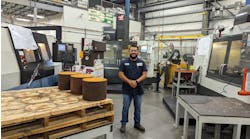IoT at M&T: An Inside Look at Toyota Operations Technology
On Wednesday, three Toyota Motor North America executives joined IndustryWeek’s Manufacturing & Technology Conference to talk about the role IT plays in the Toyota Production System and the company’s outlook on automation and the Internet of Things.
First, Jeff Moore, Senior Vice President, Unit Plants/Lexus Leader shared some statistics. Toyota has six vehicle assembly plants in the U.S., with 14 plants overall in North America. Some 365,000 U.S. jobs have been created as a direct result of Toyota operations. The company has invested $35 billion in parts and materials, and its direct capital investment in the U.S. totals $22 billion.
Priorities for this year include meeting high sales demand. “It’s shaping up to be the 7th consecutive year of U.S. market growth,” said Moore. In addition, high demand for trucks and SUVS, “so we’re squeezing all we can out of our existing capacity, improving efficiencies, working alternative shifts over time and making some small strategic investments to reduce cycle times and bottleneck processes and improve flexibility.”
Moore said that the automaker is in the process of rolling out Toyota New Generation Architecture, a common platform system to be introduced in “virtually every” North American production line in the next five years. He expects it to dramatically drive down costs and improve vehicle performance, and sees it as “huge” opportunity to introduce new production technology “beyond the normal plant projects and upgrades.”
Tim Platt, group vice president and chief divisional information officer, explained “that it wasn’t so long ago that we looked at the contributions that IT had to manufacturing, specifically to the core business, and said hmm, we’re not doing so much.”
So they set about establishing a program called Advanced IT for Manufacturing to incorporate other areas of the business. So far, the program’s North American steering committee has implemented 32 smart manufacturing systems. “In our operations and maintenance area, we’re collecting data from the plant floor and visualizing those on dashboards and reports and mobile devices,” said Platt. “We’re pulling it in that an industrial big data share so we can do cross-pillar predictive analytics.”
One of those systems, the Toyota Operations Availability System (TOAD), has saved 40,000 minutes in one plant, for a total of $6 million in avoidance and savings.
Another, a big data control tower for dashboard that provides an integrated tracking of the parts supply chain, has resulted in an $187 million per year downtime avoidance. “We recently had a a bridge closing that affected in the ballpark of 200 routes,” said Platt. “With the new capability, getting those routes going in a better direction was a matter of a few minutes.”
Moore said that at Toyota, instead of holding on to more inventory to avoid downtime during disruptions, “the better answer is to reduce production lead times and increasing our flexibility on each production line.” Keys to this are being able to run multiple product types on a line, having information systems that capture conditions in real time so team members can react quickly and having flexibility in terms of volume without impacting productivity.
The group also talked about how Toyota integrates new technologies. There are two types of opportunities to implement technology changes, said Platt. One is during a change in the production process. Another is “when we understand there’s a challenge … and we want to consider the new business processes and adoption,” and look at how technology can contribute.
“It’s not production saying hey, let’s implement this new kind of robot,” he said. “It starts with the business challenge, the business opportunity.”
Trever White, divisional information officer, noted that his team is regularly on the plant floor, building good relationships so team members can articulate what their challenges are. One challenge they recently identified was the need to build a containment system to more quickly identify and contain a quality issue when it emerges. ‘
“Now the members carry around an iPhone with a scanner on it, and no matter where the containment is, they can do a scan, they can check for whether it was impacted, they can repair the vehicle and they can confirm it,” said White. Before, “the members were going to Starbucks, they were logging in, trying to figure out where the cars were at that particular time. Now we know where they are—we can contain the issue and reduce the time. That building a good partnership generated more and more work for us.”
Platt says Toyota sees a huge IoT opportunity in putting sensors on equipment. “Even the older equipment,” he said. “We were talking about an example we had in paint. Our engineers were manually collecting data, it was taking weeks and weeks to validate a problem, we brought in one of our strategic vendors, put in a predictive maintenance tool to show proof of concept. One of the paint engineers came back and said you know it’s taken me eight weeks to figure out that was a problem; you guys did it in two hours.”
Moore noted that in North America, technology steps in when workers don’t have the deep kaizen experience that veteran Japan shop floor members have. “Just walking through their production lines they can quickly spot problems and then make quick kaizen,” he said. “We struggle more in being able to identify those problems. So we spend a lot of time on data gathering and analysis, and less time on problem solving and kaizen.” Developing a system using IoT to e able to capture data in real time, do automated analysis of it and create visualizations for team members has “helped offset the gap in experience level, and it’s been a real game changer.”
Platt said that the company looks as robots as “enabling, not taking over. They are to be used where they facilitiate strong Just in Time capabilities. They’re also there to assist the humans that are doing the job. Areas that are very labor intensive like body work where it’s hard for the team member to do what needs to be done, they’re very widely used and effective.
“As you move into some of the other areas, the team member needs to be there in order to be the thinking person who’s making the decision, who improves and kaizens the process. So you see fewer robots in those areas where we want that thinking style and that iterative kaizen principle. Robots are enabling but they’re not taking over.
Added Moore: “Robots and technology are one way to eliminate team members’ burden for those difficult jobs. But when I consider and think about the difficulty in defining Lexus quality, it’s almost an experience rather than something you can get down to numbers. It’s difficult for me to imagine automating that level of quality.”





